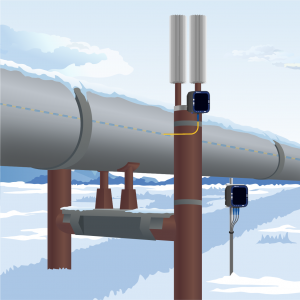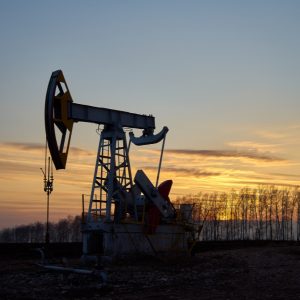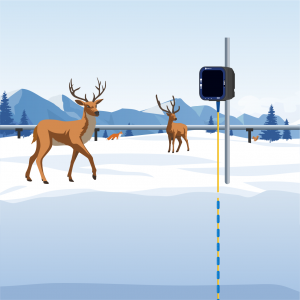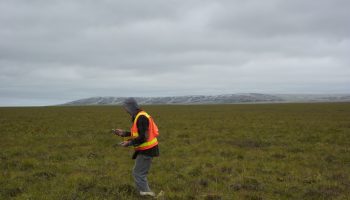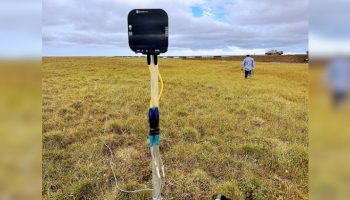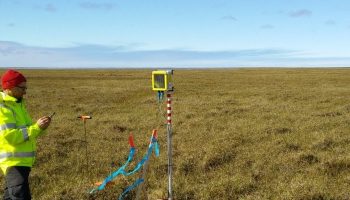Oil & Gas
Applications for the Oil and Gas industry.
Oil & Gas
Oil & Gas operations in Alaska are built on permafrost, which is thawing due to climate change. Assets such as pads, pipelines and tanks are subject to damage from the mobilization of the ground when it thaws. Monitoring the permafrost temperature profile to provide early warning of thaw and to observe the effectiveness of mitigation efforts is important for these assets. Oil & Gas applications include:
Foundations & Pads
In permafrost-rich regions, maintaining the stability of foundations and pads is paramount to the safety and longevity of structures in the oil and gas industry. Temperature monitoring plays a pivotal role in this endeavor, serving as a proactive measure against ground thawing and subsequent structural compromise. Permafrost, acting as a natural foundation, is susceptible to destabilization due to temperature fluctuations. By strategically installing temperature sensors in these areas, constant monitoring becomes feasible. This proactive approach empowers stakeholders to swiftly identify potential thawing concerns, facilitating timely interventions such as insulation or ground stabilization. By leveraging temperature monitoring solutions, oil and gas operators can safeguard their investments and ensure the structural integrity of their foundations and pads in permafrost-prone environments, mitigating risks and optimizing operational resilience.
Pipelines
In regions characterized by permafrost, maintaining the integrity of pipelines is imperative to mitigate the risks posed by ground movement resulting from thawing. Monitoring temperature fluctuations along these pipelines becomes indispensable in safeguarding against ground settlement, which can induce stress on pipelines and increase the likelihood of leaks. By strategically deploying temperature sensors along permafrost-affected pipeline routes, operators gain access to real-time data on ground conditions. This critical information enables proactive measures to anticipate and address potential challenges, including ground movement and thaw settlement. Through continuous monitoring and predictive insights, operators can uphold the reliability and resilience of their pipeline infrastructure in permafrost-prone areas, minimizing the risk of environmental harm and operational disruptions.
Tank Farms
In permafrost regions, tank farms play a vital role in storing and managing oil and gas resources. However, the unique challenges posed by permafrost necessitate specific measures to maintain the stability and structural integrity of storage tanks. Temperature monitoring emerges as a crucial tool in this regard, facilitating the assessment of permafrost thaw risks and their potential implications for tank stability. By incorporating temperature sensors within tank farms located in permafrost-affected areas, operators can establish a continuous monitoring system for ground temperatures. This real-time data enables the timely implementation of preventive strategies, such as insulating tank foundations, to mitigate the adverse effects of permafrost thaw on storage infrastructure. Through proactive monitoring and targeted interventions, tank farm operators can effectively safeguard their facilities against ground instability and uphold the reliability of storage operations in permafrost environments.
Exploration Surveying
In permafrost regions, conducting exploration surveys is crucial for unlocking valuable resources, yet it also entails unique challenges that necessitate meticulous attention to temperature monitoring. Understanding the subsurface conditions is paramount during exploration activities, as temperature fluctuations can significantly impact the stability of permafrost and influence the feasibility of resource extraction endeavors. By integrating temperature measurement tools into exploration surveys conducted in permafrost areas, stakeholders gain valuable insights into subsurface dynamics. This data serves as a cornerstone for informed decision-making processes, guiding choices related to drilling locations and resource estimation while accounting for the distinctive challenges posed by permafrost. Through comprehensive temperature monitoring and data-driven analyses, exploration teams can optimize their strategies, maximize resource potential, and navigate the complexities of exploration in permafrost environments with confidence.
Environmental/Wildlife Monitoring
In permafrost regions, preserving the delicate ecological balance is crucial, underscoring the importance of temperature monitoring for evaluating the impact of oil and gas activities on these environments. The thawing of permafrost can trigger significant alterations in habitats and disrupt wildlife ecosystems, emphasizing the critical need for ongoing environmental assessment. By deploying temperature sensors in permafrost areas, continuous monitoring of environmental conditions becomes feasible. This valuable data serves as a cornerstone for understanding the ecological implications of oil and gas operations, enabling stakeholders to develop environmentally sustainable practices. Additionally, it facilitates compliance with regulations governing activities in these sensitive regions. Through proactive environmental monitoring and informed decision-making, stakeholders can mitigate adverse impacts, safeguard wildlife habitats, and uphold the ecological integrity of permafrost environments for generations to come




